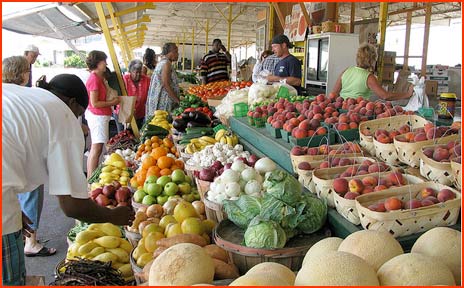
One side effect of Michelle Obama’s Let’s Move! program has been a revival of interest in farmers’ markets, both as a counter-force to the “food desert” problem and a general expression of a wish for fresh food on the part of the general population. For CNSNews.com, Susan Jones wrote about the Farmers’ Market Promotion Program, or FMPP, a government grant program which has been around since 2006, whose object is to fund projects that contribute to the physical and economic health of communities. Jones says:
The goal is to ‘increase domestic consumption of agricultural commodities’ by improving and expanding farmers markets, or creating new ones. The money is to be spent on the marketing and promotion of farmers markets; consumer education and outreach; equipment purchase; transportation and delivery; training farmers in business planning and record-keeping; or waste management and ‘green technologies.’
The program also aspires to provide communities with the means to freeze, can, and pickle food, as well as teaching students entrepreneurial skills along with the more mundane production skills. FMPP’s “Frequently Asked Questions” guide is available as a PDF file from this page. From it we learn that applicants for funding can include both nonprofit and for-profit organizations, the latter being defined as producer networks or producer associations.
The application deadline for this year was in May. The minimum grant is $5,000, the maximum $100,000. The awards will be announced in September, and the money disbursed starting in October.
The 2012 application instructions stress that the relief of food deserts is at the top of the list, so much so that the “Food Desert Project” should be included in the title. Roadside stands and farmers’ markets are encouraged. The FMPP website says:
…[F]unding priority has been given to the development and expansion of direct producer-to-consumer marketing outlets that sell healthy foods in food deserts (areas with limited access to affordable and nutritious food, particularly areas composed of predominantly lower-income neighborhoods and communities) or low-income areas (where the percentage of the population living in poverty is at least 20 percent). Projects addressing either of these priorities will receive 5 additional points in the project scoring process.
For last year’s awards, go to this page for a PDF file. The results are arranged by state, and here are a couple of random examples, including one pertaining to the Childhood Obesity News columnist’s hometown:
$90,460 to the Kohala Center, Kamuela, HI, to begin a new EBT project to provide EBT access to six farmers markets, train market managers and vendors, and promote these markets to SNAP recipients on Hawaii Island.
$77,300 to the Renaissance Project, New Orleans, LA, to begin a new EBT project to establish three new fresh mobile market sites in low-income areas of New Orleans where EBT use and SNAP enrollment will be available.
$50,000 to the Be Local Northern Colorado, Ft. Collins, CO, to expand food access for consumers through development of year-round farmers market by: 1) providing curriculum and technical assistance to producers to change production plans; 2) assess value-added product lines and season extension strategies; and 3) initiate micro-grants to facilitate more professional marketing and display materials.
Of course, there is a whole lot of cultural bias, especially amidst the young, against raw food with possibly even dirt still clinging to it. The farmers’ market, that’s granny stuff. Kids are so brainwashed to equate shiny packaging with food desirability, it might take a heap of retraining to turn that trend around.
Fortunately, more schools have gotten on board with garden-based education. If people are going to become un-addicted to hyperpalatable pseudo-foods, they need something else to eat, and if the combination of garden-based education and farmers’ markets can help even a fraction of food addicts to shake off their chains, that can only be a good thing.
Your responses and feedback are welcome!
Source: “USDA Spending $10 Million to Promote Farmers’ Markets in Michelle Obama’s ‘Food Deserts’,” CNSNews.com, 06/06/11
Image by NatalieMaynor.

 FAQs and Media Requests:
FAQs and Media Requests: 











